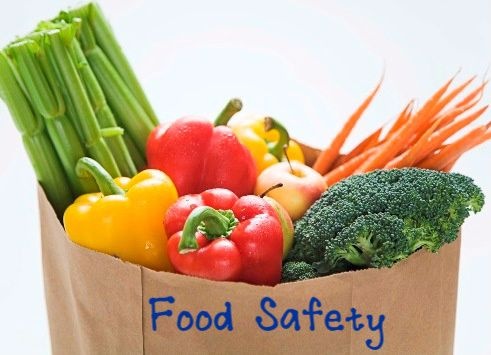 "
"
"WHY IS FOOD SAFETY A TOP PRIORITY"
Food safety is the responsibility of every person who is involved in food service. Food borne illness is considered a major public health problem. For certain highly susceptible groups, such as seniors, young children, pregnant women, and the immune-compromised, food borne illnesses can be fatal. However, for most people, a Food borne illness results in discomfort lasting several days or longer. Food service employees should know that a food borne illness could occur in any operation. Just because a food borne illness has not occurred in a food service operation does not mean it will never occur. To prevent a food borne illness, all employees must practice good food safety habits on a routine basis.
In addition to human suffering, an outbreak of food borne illness can result in a damaged reputation and financial loss. Food service employees have many opportunities throughout the day to ensure that the food served is safe to eat. In order to serve safe food, every food service employee must follow guidelines to maintain a safe food service environment.
What is a food borne illness and food borne outbreak?
- Food borne Illness
A food borne illness, commonly referred to as food “poisoning,” is a disease carried to people by food or water. Although a person may become ill and show symptoms that go
with a specific kind of food borne illness, a food borne illness can only be confirmed with a laboratory analysis that identifies the source of the illness.
- Foodborne Outbreak
A food borne outbreak is an incident in which two or more people experience the same
illness symptoms after eating a common food. A food borne illness is confirmed when a
laboratory analysis shows the source of illness to be a specific food.
- What must be done to keep food safe?
Food can become contaminated at any stage in the food service process, from field or pasture to the customer’s plate. Food borne illnesses are caused by eating a contaminated food or drinking a contaminated beverage. The first step in preventing a food borne illness is to prevent the food or beverage from becoming contaminated and thus unsafe. Any food or beverage can be contaminated (made unsafe). There are three types of hazards (or contaminants) that can cause a food to be unsafe.

1) Biological (microorganisms)
2) Chemical
3) Physical
.
As a matter of fact, people spread organisms from their bodies to food by unclean hands, coughing, or sneezing. Food can be contaminated before or during processing, in the kitchen during preparation, or during service. In fact, most food borne illnesses are caused by bacteria or other microorganisms spread by people who handle food. Also, unsanitary facilities and equipment may spread harmful organisms to people or food. In addition to this, disease spreading pests, such as cockroaches, flies, or mice, which are attracted to food preparation areas, may contaminate food, equipment, or service areas.
- What Causes Chemical Contamination
A food borne illness can result from a harmful chemical getting into a food that is then eaten by a person. Food service establishments use a variety of chemicals to clean and sanitize and for pest control. If handled inappropriately, the chemicals necessary to maintain a sanitary facility can contaminate food and make people sick. Employees who handle hazardous chemicals incorrectly also risk injury due to exposure.
- Hazardous chemicals include
1) Sanitizers
2) Pesticides
3) Whitening Agents
4) Detergents
5) Polishes
6) Glass Cleaners
7) Caustics
8) Cleaning and Drying Agents
- How Chemical Contamination Can Be Prevented
Chemical contamination of food and personal injury can be prevented if chemicals are handled and stored properly. Use the guidelines below to help prevent chemical contamination.
1) Store chemicals in original containers away from food to prevent accidental misuse as well as leakage into food.
2) Make sure labels clearly identify chemical contents of containers.
3) Use Materials Safety Data Sheets (MSDS) to ensure that all chemicals are
stored and used correctly. MSDS should be readily accessible to all employees.
4) Always measure chemicals in accordance with manufacturer’s recommendations.
5) Allow only authorized personnel to have access to cleaning chemicals.
6) Always test sanitizing solutions.
7) Wash hands thoroughly after working with chemicals.
8) Wash fresh produce that will be served whole, peeled, or cooked in cold, running
water. Scrub thick-skinned produce with a brush designed for food preparation.
9) Monitor procedures used by pest control operators to be sure pesticides do not
contaminate food. Only professional operators should apply pesticides.
10) Do not use galvanized containers to prepare or cook acidic foods like lemonade, tomato products, and salad dressing.
11) Avoid enamelware, which can chip and expose underlying metal.
12) Do not use metal mixing bowls for holding hot foods.
13) Never store food in an open can; transfer to an appropriate, covered storage container and label.
- How Physical Hazards Can Be Prevented
1) A food can be contaminated by a foreign object getting into the food accidentally. Physical contaminants include dirt, hair, nail polish flakes, insects, broken glass and crockery, nails, staples, metal or plastic fragments, and bits of packaging materials.
2) Some physical contaminants may get into the food during processing
and some may accidentally get into the food during final preparation. Either way,
physical contaminants can be harmful to the customer, and every effort should
be made to avoid any foreign object in the food.
3) Because physical hazards are easily seen, customers commonly report them. Most physical food contamination can be prevented when food service personnel wear proper clothes and shoes, use hair restraints, avoid wearing nail polish and artificial nails.
4) Use a commercial scoop rather than a glass for portioning ice.
5) In a preparation area, store toothpicks and non-edible garnishes on lower
shelves so they cannot fall into food.
6) Place shields on lights.
7) Clean can openers regularly and keep the blades sharp and in good repair.
8) Remove staples, nails, etc. from boxes in the receiving area when food is
received.
10) Avoid repairing equipment temporarily with items that could potentially fall into
food.
11) Clean and sanitize equipment on a regular basis.
12) For best practice, do not wear nail polish or artificial nails when working with
food.
13) Wear a hair restraint when working with food.
14) Do not wear jewelry or medical information jewelry other than a plain ring, such
as a wedding band, when preparing or serving food.
15) Do not carry a pencil or pen behind the ear since it could fall into food.
16) For best practice, avoid wearing earrings that could fall into food.
17) Use only food containers or bags that are approved for food storage.
18) Never reuse a single-use container.
19) Have routine pest control maintenance administered by lic



